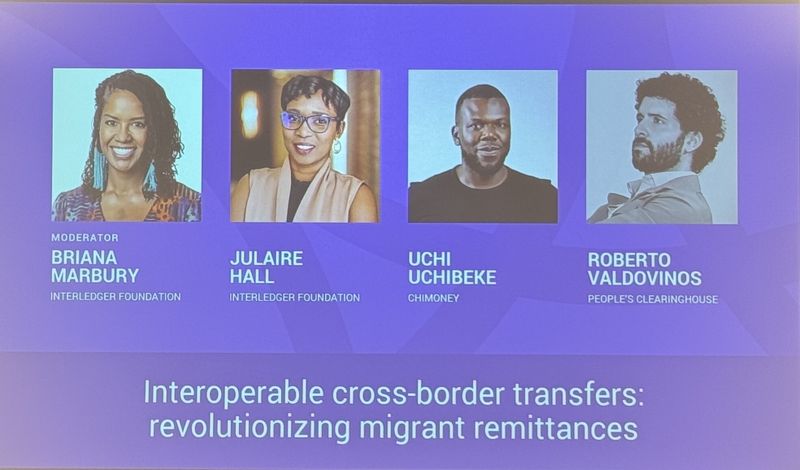Earlier this month, I had the opportunity to join a few colleagues from the Interledger Foundation in attending the 2025 Payments Canada Summit in Toronto. Hosted by Payments Canada, the steward of Canada’s core payment systems, the annual summit highlights innovations, challenges and opportunities within the Canadian payment ecosystem. Although deeply rooted in the local context, the Summit draws on global insights and perspectives recognizing that payment systems are deeply interconnected and shaped by worldwide trends in technology, regulations and financial inclusion.
ILF @ 2025 Payments Canada Summit
For the Interledger Foundation, participating in this year’s staging was strategic and a mission driven choice. As a global non-profit committed to advancing open, accessible digital financial systems, the Foundation places a high priority on cross-border payments which was one of the six deep dives and session themes of the Summit. ILF sees cross-border remittances, particularly those sent by migrant workers, as a critical area where interoperability can drive meaningful change. As such, we convened a panel discussion on the topic “Interoperable Cross-Border Transfers: Revolutionizing Migrant Remittances”. It was only right, given that Canada is a major remittance-sending country, to use the platform to highlight to an esteemed audience how within the Interledger ecosystem, open protocols and user-focused innovations are transforming remittance systems to be faster and more inclusive for all.
At the core of this panel discussion was a great focus on people, not just systems. Moderated by Briana Marbury, President & CEO of Interledger Foundation, the session highlighted the fact that global remittances are estimated to have reached US $800 billion in 2023. However, migrants often face significant challenges when sending money home including high transaction costs averaging 6%, long delays, volatility in exchange rates and other systemic barriers. These obstacles can reduce the amount of money that actually reaches recipients and create financial stress for both senders and receivers. For many people and economies, remittance is a lifeline, not just a transaction and this underscores the need to make cross-border remittances more efficient, cost-effective and accessible.
The session featured the following panelists, and here are the key highlights of main points contributed to the discussion:
- Uchi Uchibeke, CEO of Chimoney (Canada) shared his perspective on how technological innovations like digital wallets are reshaping remittance systems and are bypassing traditional banking inefficiencies to benefit users directly. Uchi highlighted Chimoney’s success in enabling instant, affordable, cross-border payments using APIs, blockchain, and mobile-first platforms; whilst emphasizing user experience and customer-oriented approach. By integrating its payment infrastructure with the Interledger Protocol (ILP), Chimoney is enabling consumers without bank accounts to send and receive money through digital wallets.
- Roberto Valdovinos, CFO of The People’s Clearinghouse (Mexico) highlighted the importance of collaboration between financial institutions, regulators and tech companies to enhance the efficiency and security of remittance services. PCH is implementing a new cross-border payment infrastructure to facilitate remittances between the U.S. and Mexican residents via community banks in rural areas; thereby enhancing financial inclusion in underserved regions. Roberto underscored the importance of upgrading infrastructure and ensuring secure, real-time data exchange are pivotal for building future-ready systems. Roberto highlighted how such systems can bridge the gap for the unbanked population, allowing for more inclusive participation in the global economy
- Julaire Hall, Program Officer of Interledger Foundation (Jamaica) provided insights on the importance of interoperability in cross-border remittances and underscored the role an enabling regulatory framework sets in facilitating seamless transactions. Referencing initiatives being implemented in various regions, Julaire highlighted the benefits of having harmonized, innovation-friendly regulatory frameworks enabling interoperable financial systems.
The panel underscored the critical role of interoperability in creating a more inclusive and efficient remittance ecosystem, particularly for underserved communities reliant on cross-border transfers. Looking ahead to the next 5-10 years, the focus must be on building global interoperability through open standards and inclusive infrastructure, while advancing regulatory clarity across borders. Remittance systems must center around the needs of migrants and underserved communities.
We were also joined by two ILF Ambassadors: Stephanie Perrin, renowned privacy and data protection expert and Andria Barrett an advocate for diversity and inclusion in the financial sector.
Now that we’ve recapped ILF’s participation, let’s talk about the 2025 Payments Canada Summit, generally.
A Transformative Moment in Payments
I must say, over the course of the two and a half days, the sessions were content rich and engaging. The event was well-attended with some 1500 attendees from various traditional financial institutions like TD Bank, CBIC, Scotiabank, just to name a few. Fintechs were also in attendance and a constant theme of discussion was their readiness and ability to leverage their strengths and collaborate in unlocking the full potential of a functioning payments system. This demonstrates a strong recognition that real-time payments is no longer just a tech story and showcases the importance of fintech innovators, bank executives, regulators, and tech providers working together to build together.
Leadership and Collaboration: Fueling the Future of Payments
A strong focus on partnership and collaboration was evident across keynotes, panels, and featured initiatives highlighted at the Summit which underscored the shared commitment to innovation and resilience in Canada’s payments ecosystem. I’d love to share a few key takeaways that highlighted important developments shaping the future of payments.
Symcor’s President & CEO, Holger Kormann, in his keynote highlighted the importance of collaboration as the world seeks to develop Interoperable cross-border payments corridors. He used the example of the automotive industry, wherein eight companies developed a charging network for electric vehicles to facilitate long-distance travel across North America. IONNA, a real-world example of interoperability in action, ensures all its charging stations are compatible with major electric vehicles, regardless of the brand. So, just like IONNA creates a cohesive digital charging system for electric vehicles, interoperability builds a cohesive digital ecosystem for data and services wherein systems and platforms can interact with each other, no matter who built them or where they’re from.
Looking further at the Canadian context, a major topical initiative mentioned and referenced at the Summit was the Real-Time Rails (RTR). RTR, an initiative being driven by Payments Canada to modernize the nation’s payment infrastructure. RTR, similar to the US’ RTP and the UK’s Faster Payments, which enables speed, efficiency, and instant, data-rich transactions every day of the year, is Canada’s long-awaited instant payment system. This transformative initiative involves numerous stakeholders; including financial institutions, government agencies/regulators, technology partners and consumers. A fundamental collaboration reshaping of how money moves, how business interacts, and how consumers engage with financial services in Canada..
One keynote that I found rather interesting and invigorating was Interac Corp's CEO, Jeremy Wilmot, whose keynote was on Canada’s tiger leap opportunity to digitalization, referenced Estonia’s Tiigrihüpe’s national initiative on modernizing the country’s digital infrastructure, amongst other national initiatives Sweden’s Swish, India’s UPI and Brazil Pix. Now, Estonia has long been referenced by many as the success story benchmark for an ideal country-level transformational initiative in developing a digitally advanced society. And the results to date are very clear, we’ve seen the key impacts like their e-residency program, e-tax, e-voting system and digital ID cards. Although Canada is making strides to digitize its payment system, he pointed out that the countries referenced depended not only on technological innovation but also on strong public trust, institutional coordination, and the ability to move quickly. To become a leader in this space, Canada must prioritize building trust among consumers and businesses, ensure interoperability across platforms, and foster agile collaboration between government, financial institutions, and technology providers. Without this alignment, the country risks falling further behind in the global digital economy. His point was further enhanced with the following quote that resonated with me:
“bold action backed by alignment outperforms caution backed by consensus”.
In reflection …
The 2025 Payments Canada Summit underscored a pivotal junction in the evolution of digital finance; one where vision, collaboration and leadership must align to drive inclusive progress. The panel discussions, keynotes, and deep dives reinforced that payment modernization is not just a technical upgrade, but a transformative process with profound social and economic implications. As we continue our work at the Interledger Foundation, we are more committed than ever to fostering systems that are open, interoperable, and built with people at the center. The road ahead demands bold action, thoughtful regulation, and unwavering collaboration.
Now as a program officer overseeing initiatives aimed at enabling digital financial inclusion, particularly those centered on digital financial services, the sobering insight from Jeff Mulholland, Partner at IBM Consulting noted that at best, only 30% of payment modernization projects will succeed, with success largely hinging on leadership, resonates deeply. This underscores the critical role of program officers not just as administrators, but as strategic leaders who must navigate complex ecosystems involving technology, policy, and underserved communities. Effective leadership in this space means fostering collaboration among stakeholders, anticipating challenges in digital adoption, and ensuring that modernization efforts are not only technologically sound but also equitable and user-centric. In a domain where the goal is to bring marginalized populations into the financial fold, strong leadership becomes the linchpin for translating innovation into lasting impact.






Top comments (0)